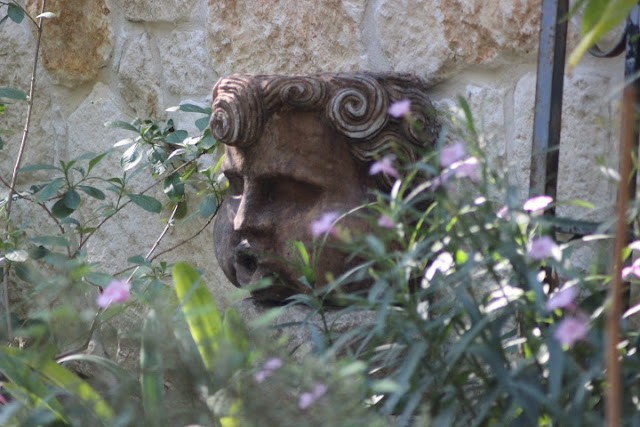In the tank garden Henry (blue) and Augusta (white) Deulberg Salvia farinacea work great together. Both went dormant during summer heat and are now back in full bloom. Blackfoot Daisy (Melampodium leucanthum) on the right backed by orange Zexmenia (Wedelia texana) along with magenta Gomphrena 'Fireworks'.
It's like an 8' diameter bouquet.
The little pink gomphrena are 'Pinball Snow Tip' and they go perfectly with 'Fireworks' and blue and white salvia.
Evening view of Gomphrena 'Fireworks' from the backside. The entire circle becomes a 30' walk-through floral arrangement.

Zexmenia and Gomphrena 'Strawberry Fields' line the circle garden, Zexmenia grows naturally on undeveloped land behind us and has been easy to transplant. It's a prolific reseeder so one or two plants have turned into many. I bought one Gomphrena 'Strawberry Fields' plant years ago and it has faithfully reseeded every year.
Brazilian Rock Rose (Pavonia hastata) is a wild spreader filling the late summer/early fall garden with its pale pink flowers.
"Monarchs this way." Just in case butterflies need a sign to find freshly planted Tropical Milkweed.
Morning blooms on tall purple Ruellia make the fence less boring.
Pink Ruellia on the other side of the garden. Just a few Ruellia plants are all you need to fill in a garden.
Fluorescent orange aloe adds fall color near the side gate.
Mexican Olive topped with tissue paper blooms.
Moy Grande Hibiscus, looks tropical but is hardy to zone 5! I planted it in a protected spot just in case.
Red Lantern hibiscus is not so hardy and spends winter in the garage. Worth it for lacy blooms.
Native Passiflora foetida grows wild along the creek behind our back fence and has naturally found its way into the garden.
As found "in the wild" just steps outside our back fence rambling over Dewberry vines near the arroyo which feeds our creek.

Snapdragon vine grows wild in the same field with the above Passion Vine and now twines the fence.
Texas native Damianita was purchased from a nursery but now looks natural in the gravel garden.
Texas Twist-rib cactus was shared by a friend.
Red Barrel Cactus blooms don't fully open.

Double yellow Datura from my friend Cliff Bingham. See my visit to his garden here.
Red Salvia microphylla rarely stops blooming.

Ending our tour with Grandma's Yellow Roses appropriately paired with a Texas flag we painted on metal roofing,
Hosted by Carol Michel on the 15th of each month, GBBD gives bloggers a meme to share what's blooming in their gardens. For more garden blooms see Carol's Garden Blogger's Bloomday post at May Dreams Gardens.


































